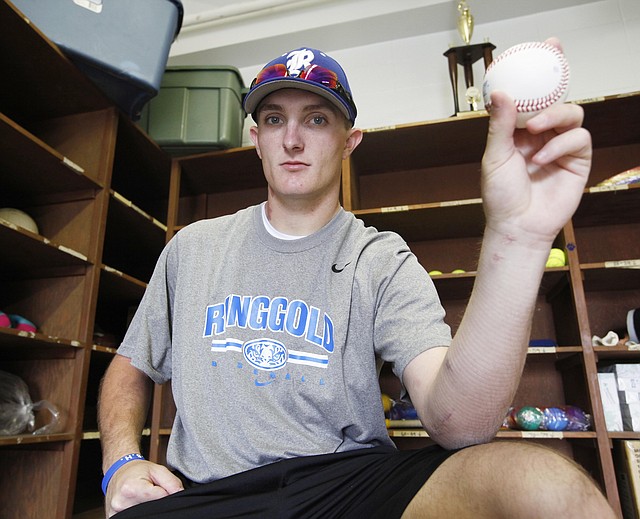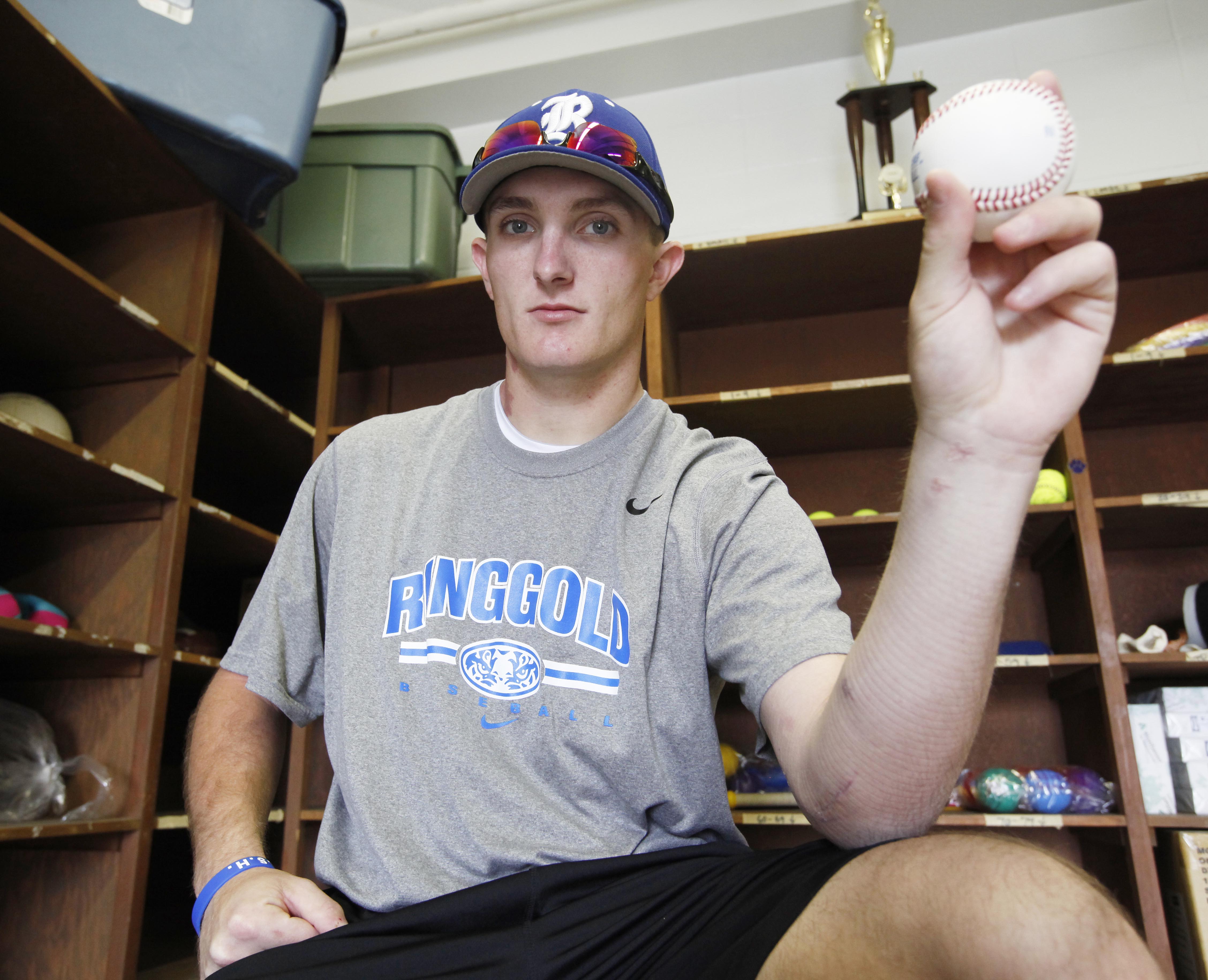Matthew Crownover part of Tommy John surgically repaired elbow trend
Friday, January 1, 1904
RINGGOLD, Ga. -- Someday soon, Matthew Crownover will shed for good the protective brace that covers his left elbow. In a few months the Ringgold High School senior again be throwing a baseball, and, if history prevails, the nationally ranked left-handed pitcher will return to the mound sometime as a Clemson University freshman, better than ever.
But why did Crownover become part of what seems to be a growing trend of teenage pitchers with surgically repaired elbows? No one ever will really know, not even renowned orthopedic surgeon James Andrews, who repaired Crownover's torn ulnar collateral ligament in a procedure first performed in 1974 on Dodgers pitcher Tommy John by Dr. Frank Jobe.
By 2006 one in every nine major league pitchers had undergone the procedure. Today it's one in every seven, and countless other pitchers at all levels have seen their careers extended after UCL tears. What used to be a career death sentence now is merely a tuneup.
What has raised the alarm of the medical community in the past few years is the increased number of teens undergoing the procedure. From 1996 to '99, Dr. Andrews performed Tommy John surgery on 164 pitchers, 19 of whom were high school aged or younger. From 2004 to '07, those numbers had increased to 588 total pitchers and 146 high school or youth league players -- a sevenfold increase.
Numbers like those open eyes and launch studies, and so far the results are what one would expect: Overuse and poor mechanics are the usual precursors to tearing the ligament, which is the weakest support system in the most vulnerable part of the arm.
"Without a doubt, the No. 1 statistical cause [of UCL injuries] is overuse," Dr. Glenn Fleisig, the research director of the American Sports Medicine Institute in Birmingham, concluded in a recent study of 18-year-old pitchers for USA Baseball. "In our studies, when a pitcher regularly threw with arm fatigue, he was 36 times more likely to be in the surgery group as opposed to the non-surgery group. That's the strongest statistical correlation in any study we've ever done. With so many pitches thrown, their total pitch count is now what a 25-year-old man used to have."
Fleisig and his ASMI colleagues (under the tutelage of Dr. Andrews) also did a study in which they chose 481 pitchers from 9 to 14 years old and documented their performances and arm injuries for 10 years. The results: Participants who pitched more than 100 innings in a year were three and a half times more likely to be injured.
Others believe the answer, or a major part of it, lies in a pitcher's mechanics. A pitcher with poor arm angle, where the elbow rises above the shoulder, is believed to be more susceptible to the injury, as are pitchers whose arms are not properly positioned to throw when the landing foot hits the mound.
The act of throwing a baseball overhand puts stress on the elbow. When the timing is not right or the elbow flies open, even more stress is applied. Over time, the UCL starts to tear. That it's happening at a younger age has pointed the spotlight directly at youth league and prep coaches and parents who want their kids to specialize in the sport and play it year-round.
"In the past 10 years, year-round baseball leagues have proliferated," said ASMI's Dr. Lyle Cain. "So the best young pitchers are throwing many more pitches and learning to throw more difficult pitches. It's great that the surgery is successful, but prevention of the injury should be the goal. This should be a wakeup call to parents and coaches that specialization in baseball where kids don't get adequate time off is very dangerous."
Crownover's coach at Ringgold, Brent Tucker, also coaches an 11-year-old team that competes in elite tournaments around the South. Tucker believes the problem with overuse starts in the pre-teen years.
"I think it starts at 9, and a lot of it is because of these showcase tournaments," he said. "We recently went to a tournament in Atlanta that was supposed to have only 26 teams but ended up with 38. To win the tournament, on the last day you would have to win five games. That's too many. The team that won it was from Miami and they had already played 75 games. There was another tournament the next weekend and 90 percent of the teams in the first one played in that one. We sat that one out.
"When my son was 9 we were in the World Series in Panama City and we got in the losers bracket on Saturday. We started playing on Sunday at 9 a.m. and we finished at midnight. If we had won that game we would have had to play again at 1 a.m. There is a showcase tournament in Jupiter, Fla., in October, when kids should be shut down. Having those tournaments in the fall is ridiculous. There has to be a time for the kids to recover."
These tournaments have pitching innings limits, but rarely does a boy pitch in one game and totally rest in the next. Every position on the field involves throwing, so the arm never gets to completely recover.
"It's not just the pitching," said Tucker, who has four kids pitch on one day and four others who pitch on the next. "They pitch one game then have to play four more, plus all the warmup time."
Still, as Tucker knows, kids have to play the sport to learn it and to improve.
"It's a fine line in baseball," he said. "If a kid doesn't pitch, he simply won't be able to do it. It really is common sense, but every kid is different. I've had some in high school that could throw 100 pitches and not get fatigued, and I've had others that get tired more quickly. Really, there is no true formula."
The coach can look at his now-injured star as proof. Crownover pitched on back-to-back days only once in three seasons and did not throw a curveball in competition until his sophomore year. He competed the past five years in the prestigious East Cobb Baseball league, where he pitched once a week and did not play the field.
His father, Ringgold assistant coach David Crownover, has been with him at every level and says there never has been overuse.
"Everybody wants to play the blame game, but I don't think you can do that," he said. "I think there are so many throws in an arm and then something like this is going to happen. I don't think Matthew could have taken better care of his arm. You could ask anybody he's played for, and they would back that up.
"In the summer he pitched every fifth day and never threw over 80 pitches in any game. Here at Ringgold he threw once a week. He's had two games he's thrown 100 pitches, and outside of the playoffs as a sophomore, he hasn't pitched on back-to-back days. He even took the fall off this year, not because his arm was hurting but because he wanted to prepare for his senior season."
The pitcher's mechanics aren't an issue, either. The ease at which he repeats his delivery was cited in a Perfect Game USA preseason article in which he was named a member of the Southeast Region Dream Team. Even Clemson's coaches lauded Crownover's delivery.
"I asked the Clemson coaches if they wanted me to work on anything in particular and they said no, that I had the cleanest delivery they had seen," Matthew Crownover said with a laugh before pausing. "There are different causes. For some it's overuse and others it's because they don't take care of their arm, and in some cases, like mine, it's how many throws you have left in your arm.
"My arm was in the best shape of my life this year; it had never felt better. It was a freak thing and I wouldn't have done anything different. I think it was just my time."

